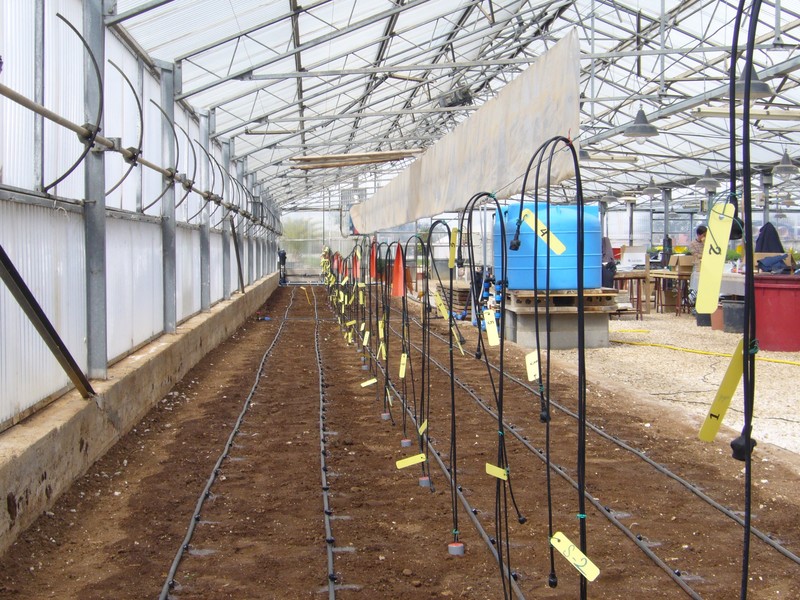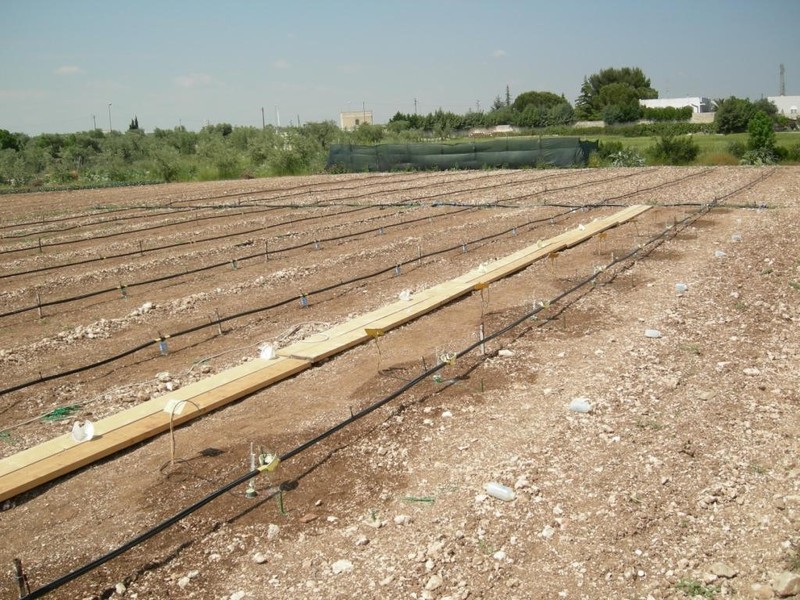Water flow and solute transport in the soil-plant-atmosphere continuum. Trials on:
1) large columns, 2) in the greenhouse, 3) in the field.
Experimentation is conducted on a group of soil columns provided at CIHEAM Bari (see sketch in the figure). The details on the use of equipment and on trial management are the subject of specific trainings held at the Soil Hydrology Laboratory of CIHEAM Bari.
Columns are fed from the top using a perspex rainfall simulator. For specific trials, column feeding shall be ensured using:
Columns are supplied with a draining bottom constituted by stratified different textured-materials including, in the order from the bottom: 6cm of gravel; 3cm of coarse sand; 3cm of inert material (fossil meal) with high specific permeability (> 4 darcies).
Trials may be grouped into the following categories: a) Infiltration trials, b) Trials of miscible flow with tracers, c) Treatment cycles with marginal water (saline water, municipal and industrial waste).

The measuring device shown below has been set up to define the hydraulic and hydrodynamic dispersion of the soil under controlled conditions (greenhouse).
In short, the device supplies the soil with water flow rates between 2 and 12 l/h applied by means of self-compensating on-line drippers mounted on a hydraulic network consisting of dripping lines. It also provides the monitoring of water contents and of bulk electrical conductivity at 3-4 depths, using TDR probes developed at CIHEAM Bari and installed along a 50 m row and 1m spacing. Soil hydrological properties will be estimated from three-dimensional flow fields under the drippers in different monitoring sites.
Within the H2020 project, named MAD4WATER, between 2016 and 2020 greenhouses will accommodate growth trials conducted on some crop species under different watering regimes with and without the inoculation of GBG bacteria, adequately selected at the University of Milan.
Water and salt transport from the soil surface through the root-zone to the aquifer may be described using mathematical models that enable the estimate of evaporation and percolation losses, the expected residence time and water dynamics, at the same time.

Due to the intrinsic diversity of soils, the parameters for their characterisation are largely variable in the space and over time; therefore, to achieve outcomes useful for practical applications, a great deal of data are required for using mathematical models. Moreover, improvements in the equipment for the measure of transport parameters are expected to ensure sufficient accuracy and minimum costs.
Considering the need to collect an appropriate number of field observations, which are particularly useful for the parallel research trials run at the Soil Hydrology Laboratory of CIHEAM Bari, a specific device for the field determination of hydrologic parameters in porous media has been developed, as shown in the figure below.
The apparatus uses a double-comb network of dripping lines, constituted each by three overlapping lines supporting 2.5 m spaced self-compensating drippers with a flow rate ranging between 2 and 12 l/h. The parallel monitoring of water contents and of soil water pressure potentials will be ensured through TDR probes and tensiometers, respectively.
Soil hydrological properties will be estimated from three-dimensional flow fields under the drippers in different monitoring sites.
In short, the above equipment and testing methods enable:
The above studies will also provide the information required to extend the outcomes of research to the relevant scales (scheme, basin) for applications, with special reference to agri-environmental issues.